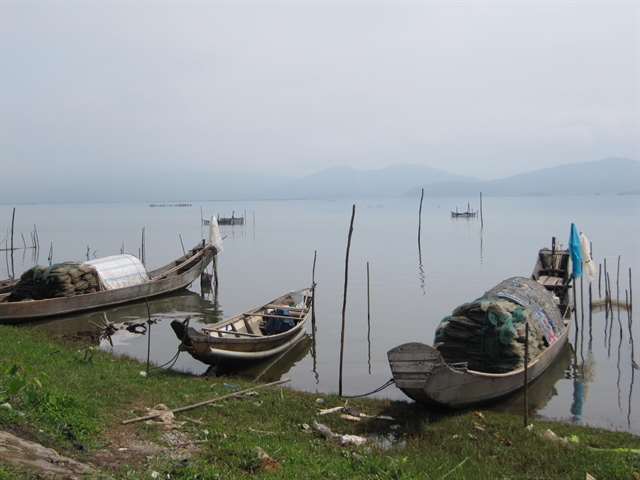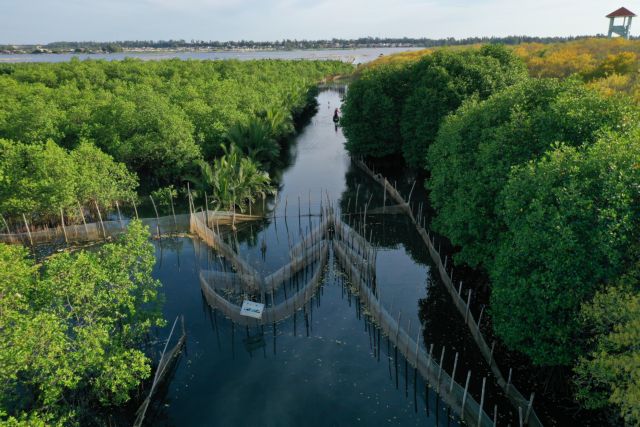 Environment
Environment


|
| Fishing boats docked at Tam Giang – Cầu Hai Lagoon, a wetlands nature reserve in Thừa Thiên Huế Province. Plastic pollution is a cause for concern as dumped rubbish is contaminating river and lake systems, including the Tam Giang – Cầu Hai Lagoons – the largest wetland ecosystem in Southeast Asia.. VNS Photo Công Thành |
THỪA THIÊN-HUẾ — Huế City, a tourism hub in central Việt Nam, aims to cut its plastic waste by 30 per cent before 2024 and will be a ‘zero plastic waste’ destination by 2030.
The target was pledged at a conference for a project entitled 'Huế - plastic smart city in central Việt Nam', funded by the World Wildlife Fund (WWF-Việt Nam).
The project plans to help the tourism hub build a plastic-smart city, where 70 per cent of solid waste will be classified 'at source' for recycling in 2021-24.
Among a total of 407 tonnes of daily urban waste being collected, 63 tonnes of plastic waste are released each day. A report from the city’s urban and environmental unit unveiled that 3.13 per cent of plastic waste is still leaking back into the environment.
The unit said plastic pollution is a cause for concern as dumped rubbish is contaminating river and lake systems, including the Tam Giang-Cầu Hai Lagoons – the largest wetland ecosystem in Southeast Asia.
Local residents living along the Hương River and lakes still discharge household waste into the water system, and waste has piled up and polluted the lagoons for decades.
The WWF-Việt Nam funded project will help improve solid waste management in the city, thanks to involvement from communities and businesses. Awareness will also be raised on plastic pollution among local people.
It is hoped that plastic consumption and discharge into the environment will be reduced as a result. Household waste collection and the classification of recycling will be improved to further limit waste amounts in landfills.

|
| Rú Chá, a mangrove wetland forest, is an eco-tour site in Thừa Thiên Huế. The province has pledged to reduce plastic waste by 2024. Photo courtesy of Hồ Cầu |
Thừa Thiên Huế has many lagoons, including Tam Giang-Cầu Hai, Thủy Tú and Lập An. Almost all the rivers in the province converge before flowing into the sea, through the estuaries of Thuận An and Tư Hiền, or through the great lagoon of Lăng Cô.
The newly recognised Tam Giang – Cầu Hai Lagoon Wetlands Nature Reserve, the largest lagoon system in Southeast Asia, covers the districts of Phong Điền, Quảng Điền, Hương Trà, Phú Vang and Phú Lộc. It is well known for its biodiversity with 21 endangered species and 921 water species, including rare fish and plants. It also provides food and shelter to 73 migrating bird species.
In 2018, the US Agency for International Development (USAID) provided a non-refundable assistance package worth US$53,858 for the province to implement urban waste recycling.
Huế City, along with other cities in Việt Nam like Đà Nẵng, Hội An (Quảng Nam Province) and Đông Hà (Quảng Trị Province), entered the 'One Planet City Challenge' programme in 2017, to show how cities can become hubs for creativity, ambition and innovation in dealing with climate change.
In 2016, the WWF recognised Huế City as Việt Nam’s National Earth Hour Capital 2016, as part of the highly selective global Earth Hour City Challenge. — VNS




